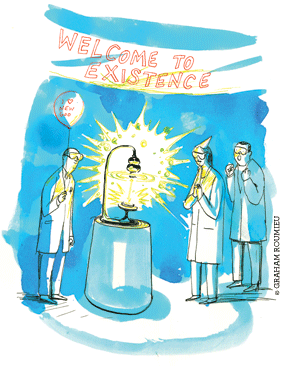
On May 20 of this year Craig Venter, who led one of the first successful efforts to sequence the human genome in the 1990s, announced an even more audacious breakthrough: After more than 10 years of work, his laboratory had created life. Working on a kind of updated version of the Frankenstein model, Venter’s team digitally sequenced a bacterial genome, physically built genetic code out of four chemicals, and inserted it into an empty cell that had been vacated of its own DNA. He hailed their creation as “the first self-replicating species we’ve had on the planet whose parent is a computer.”
That same day President Barack Obama sent a letter to Penn President Amy Gutmann. The previous November he had installed her as the chair of his Presidential Commission on Bioethical Issues [“Gazetteer,” Jan|Feb 2010] and now he had the first topic he wanted Gutmann’s 13-person committee, which includes Penn Law Deputy Dean Anita Allen, the Henry R. Silverman Professor of Law and Philosophy, to undertake “a study of the implications of this scientific milestone, as well as other advances that may lie ahead” in the nascent field of synthetic biology. The president further requested that the commission deliver its findings to him within six months.
Gutmann’s selection as chair signaled a departure from the way the previous bioethics commission had operated during the George W. Bush years. Her predecessors in the role—Leon Kass and Edmund Pellegrino—had presided over a panel that was accused of being overtly ideological, particularly with regard to recommendations around embryonic stem cell research. Gutmann, by contrast, is known more for her work as a political theorist—arguing for a deliberative approach to difficult issues—than for her stances on any specific bioethical issues, and her selection by Obama was widely interpreted as an indication that he preferred his commission to undertake a practical, policy-minded inquiry.
On September 13 and 14, Gutmann hosted the commission at Penn, where it held the second of three rounds of public hearings it will stage prior to delivering its final recommendations to President Obama. Gutmann opened the program by describing her hope that “by sharing well-reasoned perspectives and robustly deliberating about matters of public importance … [the commission] will serve the public good and also strengthen the fabric of our democracy.”
The first round of hearings had taken place in Washington in July, where Venter was called to speak as the commission developed a baseline understanding of synthetic biology. The Penn hearings explored the wider implications of the emerging technology, and to that end a slate of religious leaders, synthetic biologists, patent scholars, and bioethicists (including three members of Penn’s faculty) was invited to testify.
The star of the first day of the hearings was James Collins, a wiry, intense professor from Boston University who is credited as one of the founders of synthetic biology. Collins delivered a tour de force PowerPoint presentation (yes, such a thing is possible) outlining just how it is that scientists are able to rig up a living cell the way electrical engineers program a circuit.
Nearly all of the diagrams and equations in his slides, and much of what he said, was dauntingly technical for a lay audience, but still his presentation had the palpable air of genius about it. He mused about designing cells that could sense toxins in the environment, convert biomass into fuel, or stanch protein production in renegade human cells to accomplish a clinical result.
After retaking his seat at the commission’s witness table, Collins was asked to describe the risks of creating such new forms of life. “Imagine if somebody [created an organism] that degrades plastic rather quickly, which would be a great environmental find,” he said, offering an example. “Well … this might end up on your lapel, and you take it home and when you wake up your car is no longer in the driveway. What’s left are the few steel parts that are still in modern cars because the organism grew and ate everything.”
That speculation prompted Gutmann to quip that the only movie she was ever too scared to finish was the 1958 sci-fi film The Blob, and for the rest of the day “the blob” was invoked by various commission members as shorthand for the risks of synthetic biology, each time eliciting chuckles from the crowd.
Science-fiction scenarios were invoked often during the hearings, and during an afternoon panel Penn’s Jonathan Moreno posited that it was precisely these “extremely low-probability but extremely high-magnitude” events that the commission should be worrying about. Moreno, the David and Lyn Silfen University Professor and a senior fellow at the Penn Center for Bioethics, said that when figuring out how to regulate synthetic biology, the commission should focus on determining “the acceptable worst-case scenario.” He cited the work of British physicist Martin Rees, who has estimated that humanity’s chances of making it through the next century are only 50 percent; Moreno argued that these types of existential calculations should be part of the commission’s deliberations.
A theme throughout the hearings was the degree to which synthetic biology is qualitatively different than the ways scientists have been manipulating genes for years to create recombinant viruses, genetically modified plants, and other variant forms of life. “The field is relatively new,” Gutmann noted in an interview after the hearings concluded, “though many see it as the continuation of long-standing practices in molecular biology and genetic engineering.” Indeed, a number of witnesses proposed that existing Environmental Protection Authority regulations and intellectual-property rules were sufficient to govern synthetic biology, however the field evolves.
Still, the question remained: If synthetic biology is in fact on a continuum with existing scientific practices, what exactly had Craig Venter accomplished when he declared that he’d created the world’s first synthetic cell, and what exactly does it mean for our understanding of life that an entire genome could be recreated artificially?
Answering those questions fell to the 83-year-old molecular biologist Sydney Brenner. In 2002 Brenner won the Nobel Prize in Physiology or Medicine for research that plumbed the genetics of cell development. He remains active in the field and is regarded as something of a wise man of science.
For two days Brenner had sat in the front row of the audience periodically shaking his head in disagreement with the more apocalyptic and optimistic implications attributed to Venter’s work. Finally, on Tuesday it was his turn to speak. Though all the presenters who preceded him had had their speaking time tightly monitored by a system of electronic chirps and blinking lights, there was a sense that the commission would have been happy to let Brenner talk all day.
Speaking like a man whose scientific stature and advanced age gave him a unique perspective on the constitutive elements of life, Brenner went straight at Venter. “He’s a forger, he’s created counterfeit genomes,” Brenner said. “This is not a novel thing. He’s synthesized nothing.” Brenner pointed out that the genome Venter had sequenced was a near replica of an existing bacterial genome. He drew the analogy that being able to synthetically reproduce a genome is equivalent to being able to copy a text written in a language you can’t read—the copying by itself proves neither that you understand the language nor that you have the ability to employ it to create new works.
It was an odd moment to hear the commission’s most distinguished witness say that the breakthrough discovery that had prompted the inquiry was really nothing of the sort. Penn’s Anita Allen picked up on this, asking Brenner: “I’m wondering if you were challenged to put [Venter’s] innovations in the most positive light, what language would you use?” What Venter has shown, Brenner replied, is that you can “substitute one genome by another” and that it is technologically possible to accurately sequence a one million base pair genome, both necessary but far from sufficient conditions for the creation of synthetic life.
Brenner’s most striking comments, though, came when he laid out the steps that would need to be taken to truly synthesize life. Venter’s demonstrated ability to accurately sequence a one million base pair genome was no small feat. But the real test of creating life, and of creating new forms of life, Brenner said, lies in a far deeper understanding of how exactly an inert set of genetic directions manifests into protein synthesis, thereby animating what would otherwise be inanimate. And that knowledge, he said, was not coming anytime soon.
“My own experience,” Brenner said, “is that it is extremely difficult to make something new, because what we really want to design are proteins that do the work … and I think that we are very far from being able to do this, very far.”
Be that as it may, the capabilities many scientists expect to gain along the way have pushed synthetic biology to the top of the commission’s agenda. It will hold its final public hearing on the topic on November 16 and 17 in Atlanta. Gutmann will then lead what promise to be intensive deliberations to sort through the diverse opinions her commission has solicited. Their final report is due on President Obama’s desk by the end of the year.
—Kevin Hartnett




